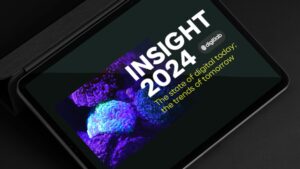There is no doubt that mobile technology is shaping our future. The mobile device has achieved market success and is currently more accessible than running water around the globe. In the last few years we have seen a massive increase of businesses offering services in the mobile arena with mobile banking probably one of the biggest services creating the most interest.
When asked to look at the future of mobile I believe that you need at look at three main aspects:
- The internet of things
- Social Disruption
- Infrastructure
Over the next three weeks I will take a look at each of these aspects. To start lets take a look at ‘the internet of things.’
The internet of things
Wikipedia says it best “Today computers—and, therefore, the Internet—are almost wholly dependent on human beings for information. Nearly all of the roughly 50 petabytes (a petabyte is 1,024 terabytes) of data available on the Internet were first captured and created by human beings—by typing, pressing a record button, taking a digital picture or scanning a bar code. Conventional diagrams of the Internet … leave out the most numerous and important routers of all – people. The problem is, people have limited time, attention and accuracy—all of which means they are not very good at capturing data about things in the real world. And that’s a big deal. We’re physical, and so is our environment … You can’t eat bits, burn them to stay warm or put them in your gas tank. Ideas and information are important, but things matter much more. Yet today’s information technology is so dependent on data originated by people that our computers know more about ideas than things. If we had computers that knew everything there was to know about things—using data they gathered without any help from us—we would be able to track and count everything, and greatly reduce waste, loss and cost. We would know when things needed replacing, repairing or recalling, and whether they were fresh or past their best. The Internet of Things has the potential to change the world, just as the Internet did. Maybe even more so.”
In simpler terms, if we could find a way for inanimate objects to capture data to the internet we would be able to create databases of information of extreme value. In addition if we could create systems that initiated processes based on this data collected we could manage simple important processes better, with less human error.
A move to wearable tech
Finally we need to understand that the applications we use on our phones may find more convenient homes inside devices that we wear.
Google is about to launch Google Glasses which takes its services to eye where and Nokia are looking at similar technology to make the telecommunications experience more natural.
A collegue of mine just ordered his pebble watch which will control his andriod phone, making it easier to see whose calling, accept calls, use music applications and a host of other services that we like to have quick access to.
Shoes could become better objects to track our running and send that data to the cloud which will in turn send it back to our phones with a summary of our performance.
As we consider the future of mobile we really need to break out the box of the mobile phone and explore every single mobile device.
Smart Metering
A simple idea with big impact. Utilising the internet of things you are able to monitor how water is used, petrol is consumed, the temperature of fridges and many other aspects that normally are difficult to monitor in real time.
A great example of this in the health sector managing the temperature of blood from donors. This blood needs to be kept at a specific temperature. A change by one degree either way may cause that blood to be unusable. As blood is in short supply it makes sense to do everything we can to ensure nothing goes wrong with the temperature.
M2M communication can monitor the temperature of the fridge and then make necessary adjustments in real time to accommodate any changes taking place.
Working towards a smarter city
Vodafone have been taking big strides forward in this arena and have been working with Venice to create a ‘Smart City.’
Traffic is managed by machines talking to each other, sending data back and forth, (known as machine to machine communication or m2m) and finally collected in a central location. The data collected in this location has been able to provide insight into better traffic management to allow for higher security, environmental improvements and a decrease in traffic congestion.
Parking in payzones is now managed by sms by allowing people to sms their starting and ending parking times and allowing them to pay through a ‘phone call.’ Meanwhile the administration of parked vehicles by officials can be done with a tablet with online access or any mobile phone.
Local citizens can subscribe to notification services about election news, changes in bus routes, council meetings and a variety of other notice based servcies.
These are just a few ways that Venice has been using the internet of things to create a smarter city.
To close off this post here is a very interesting video from the smart people at IBM on the internet of things.






